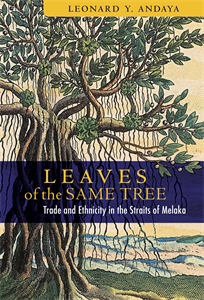Leaves of the Same Tree: Trade and Ethnicity in the Straits of Melaka
- About the Book
-
Despite the existence of about a thousand ethnolinguistic groups in Southeast Asia, very few historians of the region have engaged the complex issue of ethnicity. Leaves of the Same Tree takes on this concept and illustrates how historians can use it both as an analytical tool and as a subject of analysis to add further depth to our understanding of Southeast Asian pasts. Following a synthesis of some of the major issues in the complex world of ethnic theory, the author identifies two general principles of particular value for this study: the ideas that ethnic identity is an ongoing process and that the boundaries of a group undergo continual—if at times imperceptible—change based on perceived advantage. The Straits of Melaka for much of the past two millennia offers an ideal testing ground to better understand the process of ethnic formation. The straits forms the primary waterway linking the major civilizations to the east and west of Southeast Asia, and the flow of international trade through it was the lifeblood of the region. Privileging ethnicity as an analytical tool, the author examines the ethnic groups along the straits to document the manner in which they responded to the vicissitudes of the international marketplace. Earliest and most important were the Malayu (Malays), whose dominance in turn contributed to the “ethnicization” of other groups in the straits. By deliberately politicizing differences within their own ethnic community, the Malayu encouraged the emergence of new ethnic categories, such as the Minangkabau, the Acehnese, and, to a lesser extent, the Batak. The Orang Laut and the Orang Asli, on the other hand, retained their distinctive cultural markers because a separate yet complementary identity proved to be economically and socially advantageous for them. Ethnic communities are shown as fluid and changing, exhibiting a porosity and flexibility that suited the mandala communities of Southeast Asia.
Leaves of the Same Tree demonstrates how problematizing ethnicity can offer a more nuanced view of ethnic relations in a region that boasts one of the greatest diversities of language and culture in the world. Creative and challenging, this book uncovers many new questions that should revitalize and reorient the historiography of Southeast Asia.
- About the Author(s)
-
Leonard Y. Andaya, Author
- Reviews and Endorsements
-
- This is a marvelous book. In the widest sense it is a history not merely of ethnicity, but of economy, politics, and culture—as close to a total history of the western (and central) archipelago during two millennia as we are likely to have for some time. Andaya’s mastery of local geography, economic rhythms, commercial organization, political culture, elite family networks, literary production, and religious currents is apparent throughout the text and, together with his control of the diverse secondary literature and expertise in Dutch and Malay primary materials, gives his work a unique authority.
—Victor Lieberman, University of Michigan - This book rests on an impressive range of materials and careful reflection over a broad sweep of history. Leonard Andaya’s analysis of ethnicity importantly demonstrates its plasticity, complexity and situational character. Ascribing ethnic definitions and redefinitions in the Straits of Malacca primarily to the impact of trade from the seventh century onward, Andaya suggests approaches to the concept and social reality of ethnicity that historians and others should study seriously.
—M. C. Ricklefs, National University of Singapore - Few scholars have roamed as widely as Leonard Andaya in his historical peregrinations across the Malay Archipelago. Andaya has written on a broad band-width of worlds, from Aceh to Johor and from the Java Sea across to Eastern Indonesia. He has done this in over three decades of meticulous scholarship, and always with savvy and historiographical nous. This book sums up a lifetime of learning about the western reaches of the archipelago, and the place of ‘ethnicity’ in these disparate lands. More importantly, it will make you want to jump aboard fast wooden ships, green sea in the air
—Eric Tagliacozzo, Cornell University
- This is a marvelous book. In the widest sense it is a history not merely of ethnicity, but of economy, politics, and culture—as close to a total history of the western (and central) archipelago during two millennia as we are likely to have for some time. Andaya’s mastery of local geography, economic rhythms, commercial organization, political culture, elite family networks, literary production, and religious currents is apparent throughout the text and, together with his control of the diverse secondary literature and expertise in Dutch and Malay primary materials, gives his work a unique authority.
- Supporting Resources
-










